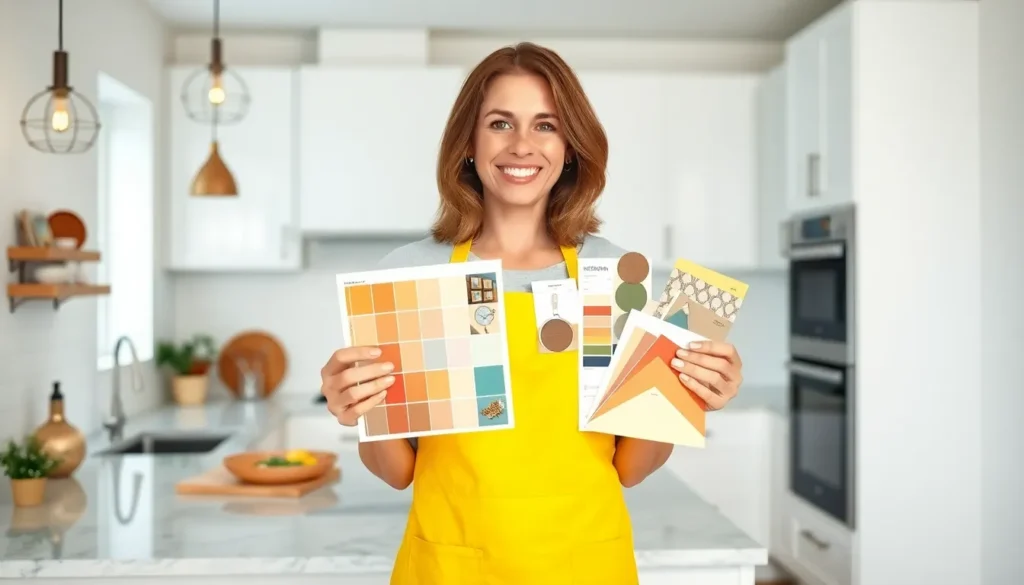A kitchen makeover can transform the heart of the home into a stunning and functional space. With the right tips and tricks, anyone can breathe new life into their kitchen without breaking the bank. Whether it’s a complete overhaul or simple updates, small changes can yield impressive results.
From refreshing color palettes to innovative storage solutions, these kitchen makeover tips will inspire creativity and practicality. Embracing trends while considering personal style ensures a kitchen that’s not only beautiful but also uniquely tailored to individual needs. Dive into these ideas and discover how easy it is to create a space that reflects both style and functionality.
Kitchen Makeover Tips Overview
A successful kitchen makeover combines aesthetics, functionality, and personal style. Consider these practical tips to transform your kitchen effectively:
- Assess Your Space: Evaluate kitchen dimensions and layout. Identify areas for improvement, whether through reconfiguration or enhancing flow.
- Choose a Color Palette: Select colors that evoke desired moods. Neutral tones provide versatility, while bold colors can create focal points.
- Upgrade Fixtures: Replace outdated fixtures with modern options. Consider energy-efficient appliances and stylish faucets to elevate the overall look.
- Incorporate Storage Solutions: Maximize storage using creative methods. Use vertical space with shelves or organizers, and integrate pull-out cabinets for easy access.
- Add Lighting: Install various lighting types, including ambient and task lighting. Under-cabinet lights enhance functionality while providing a warm atmosphere.
- Use Textures Wisely: Mix materials for added interest. Combine finishes like wood, metal, and tile to create depth and character.
- Personalize the Space: Incorporate personal touches through decor. Art, plants, and cookbooks can reflect individual style while enhancing warmth.
- Plan for Functionality: Ensure all elements work cohesively. Design work zones for cooking, prepping, and cleaning to streamline tasks.
- Focus on Details: Pay attention to small elements like cabinet hardware and backsplash designs. These details can significantly impact the overall aesthetic.
- Budget Smartly: Prioritize updates based on impact and cost. Allocate funds to areas that will offer the most significant improvement for your investment.
By following these tips, anyone can achieve a beautiful, functional kitchen makeover that suits their lifestyle and preferences.
Planning Your Kitchen Makeover

Planning a kitchen makeover involves strategic steps to maximize both aesthetics and functionality. The process starts with defining a budget and developing a design vision.
Setting a Budget
Establishing a budget sets clear financial parameters for the project. Allocate funds for key elements like cabinetry, countertops, and appliances. Prioritize areas that require immediate attention, such as outdated fixtures or storage solutions. Consider setting aside 10-20% of the budget for unexpected expenses. Research costs for materials, labor, and services from local contractors to ensure alignment with financial goals.
Creating a Design Vision
Developing a design vision guides the entire makeover process. Identify preferred styles, such as modern, farmhouse, or minimalist, to frame the design approach. Use inspiration from design websites, magazines, or social media platforms. Consider creating mood boards to visualize color schemes, textures, and layouts. Focus on ergonomics by ensuring that work zones—like the cooking and prep areas—enhance efficiency. Incorporate personal touches with decor that reflects individual taste while also considering durable and functional materials for practicality.
Choosing the Right Materials
Selecting the appropriate materials is crucial for a successful kitchen makeover, impacting both aesthetics and functionality. High-quality materials enhance durability and elevate the overall appearance of the kitchen.
Cabinets and Countertops
Cabinet materials vary widely, each offering distinct advantages. Plywood provides strength and resistance to moisture, while solid wood presents a classic appeal and longevity. For a more budget-friendly option, medium-density fiberboard (MDF) delivers a smooth finish, perfect for painting.
Countertop choices also significantly influence kitchen ambiance. Quartz offers durability and low maintenance, while granite adds a touch of luxury. Laminate, a cost-effective alternative, comes in various colors and patterns, providing versatility. When selecting, consider factors such as usage, maintenance, and budget to find the ideal balance between style and practicality.
Flooring Options
Flooring materials impact the kitchen’s feel underfoot and durability. Tile stands out for its resistance to stains and water, making it a popular choice for high-traffic areas. Hardwood provides warmth and character but requires regular maintenance to keep its finish intact.
Vinyl flooring is an economical option, offering a wide range of designs while being easy to install and clean. Additionally, consider the slip resistance of materials to enhance safety, especially in areas prone to spills. When choosing flooring, think about the kitchen’s overall style that complements the chosen cabinets and countertops while ensuring comfort and longevity.
Color Schemes and Aesthetics
Color schemes significantly influence a kitchen’s aesthetic appeal and ambiance. Choosing the right palette can bring warmth, brightness, or a modern touch to the space.
Popular Color Trends
Neutral colors remain a staple for kitchens due to their versatility and timelessness. Whites and creams create a clean, spacious look, while grays and beiges add sophistication. Bold colors, like navy blue and forest green, are increasingly popular for cabinetry, offering a dramatic yet elegant vibe. Pastel shades, such as soft pink or mint green, contribute to a vintage or farmhouse style, making kitchens feel inviting.
Two-tone kitchens allow for creativity, enabling contrasts between upper and lower cabinets. This trend highlights design elements and can visually separate spaces. Accent colors, found in backsplashes or decor, add personality without overwhelming the space.
Lighting Considerations
Lighting plays a critical role in enhancing kitchen aesthetics while providing essential functionality. Layering different lighting types—ambient, task, and accent—creates a well-lit environment. Ambient lighting, such as ceiling fixtures, provides overall illumination for the entire space. Task lighting, including under-cabinet lights, focuses on work areas like countertops and cooking spaces.
Accent lighting, such as pendant lights over islands, adds character and draws attention to design features. Dimmable options offer versatility, allowing for adjustments based on the time of day or occasion. Choosing warm-toned bulbs can create a cozy atmosphere, while cooler tones may contribute to a modern, clean look. Thoughtfully placed lighting can transform a kitchen and highlight chosen color schemes, enhancing both style and functionality.
Incorporating Smart Technology
Incorporating smart technology enhances kitchen functionality and efficiency. Smart kitchens utilize devices that offer convenience, control, and connectivity.
- Smart Appliances: Smart refrigerators, ovens, and dishwashers allow users to control settings remotely. For instance, a smart oven enables preheating or cooking adjustments via a smartphone app.
- Voice-Controlled Assistants: Devices like Amazon Echo or Google Nest integrate seamlessly into the kitchen environment. They help with tasks, such as providing recipe instructions or setting timers, all through voice commands.
- Smart Lighting: Smart bulbs and fixtures offer customizable lighting options, adjusting brightness and color temperature based on the time of day. Users can create specific moods, enhancing the overall kitchen ambiance.
- Smart Thermostats: Integrating smart thermostats ensures optimal temperature control while conserving energy. These devices can adjust cooking environments based on usage patterns, leading to energy savings.
- Smart Plugs and Outlets: Smart plugs allow users to remotely control kitchen appliances, such as coffee makers or slow cookers. Scheduling these devices improves convenience and saves time in daily routines.
- Smart Kitchen Hubs: Centralized control panels bring together all smart devices, enabling users to manage them from one location. This reduces clutter and streamlines operations in the kitchen.
- Recipe and Meal Planning Apps: Integrating meal planning and recipe apps within smart devices simplifies meal preparation. Users can access thousands of recipes, allowing easy modifications for dietary needs.
- Home Security Features: Smart cameras and alarms enhance kitchen security. Many systems can send alerts directly to smartphones, ensuring peace of mind while cooking or entertaining.
Adopting smart technology in the kitchen creates a more intuitive space. Each device integrates into the home, improving efficiency and adding a modern touch to any kitchen makeover.
Transforming a kitchen is an exciting journey that can significantly improve both its look and functionality. By integrating thoughtful design choices and practical updates, anyone can create a space that reflects their personal style while meeting their needs.
Focusing on elements like color schemes, smart technology, and efficient layouts can elevate the kitchen experience. With careful planning and a clear vision, achieving a stunning kitchen makeover is entirely possible. Embrace the process and enjoy the rewards of a beautifully revamped kitchen that enhances daily living.





